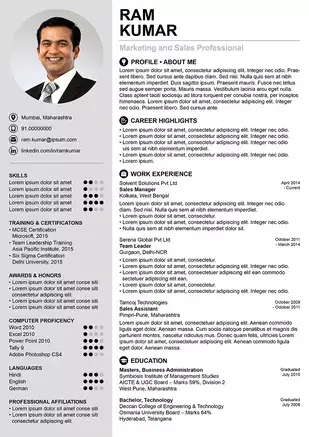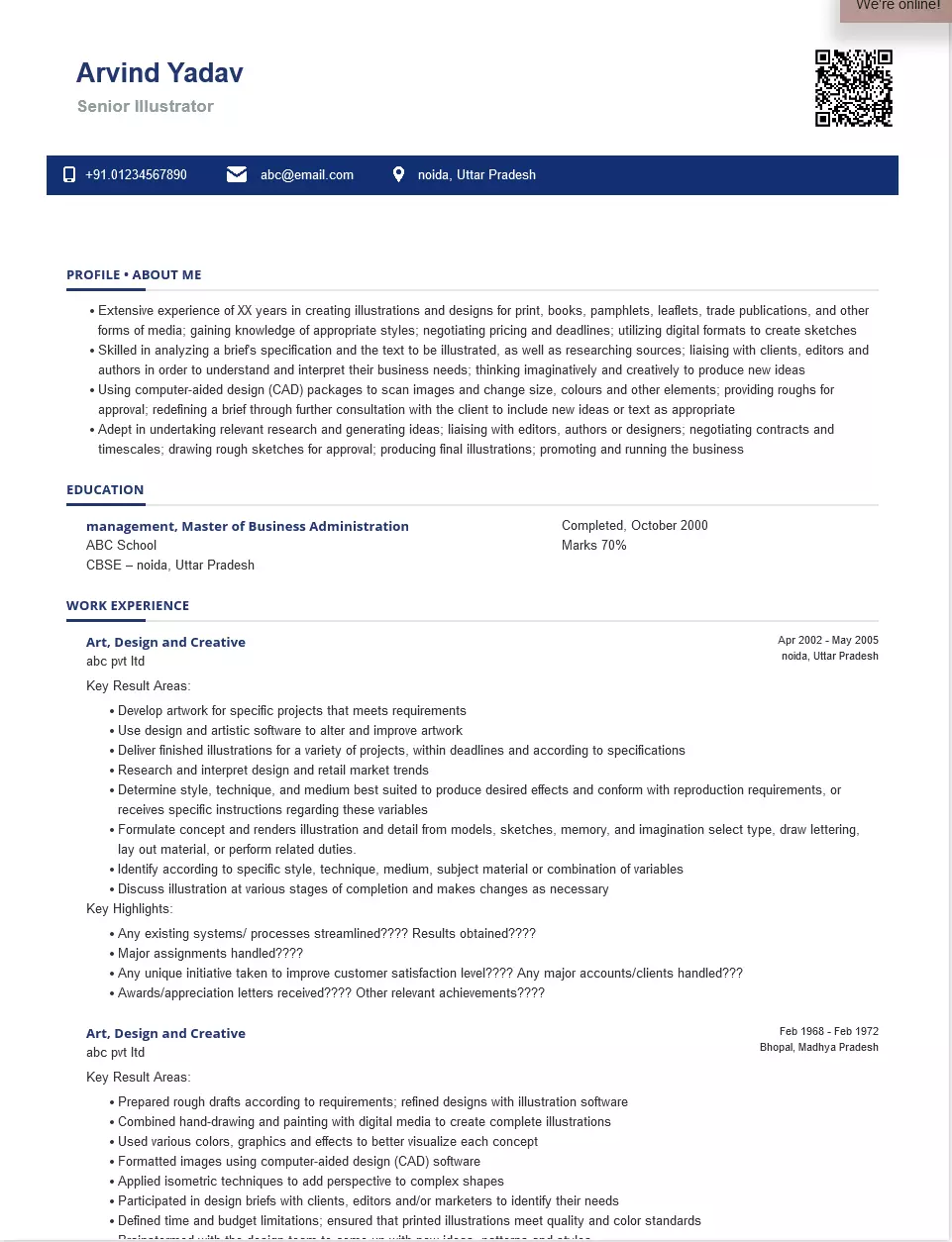- Adobe Certified Expert: Illustrator, Completed , January 2006
- Adobe Certified Associate: Visual Communication Using Adobe Illustrator, Completed , January 2012
- Autodesk Certified Professional: AutoCAD Illustration, Completed , January 2009
What's your job?
Illustrator Resume Samples and Templates for 2026
- Table of Contents
- Downloadable Sample
- Resume Tips from Experts
- Resume Text Version
- Share
Illustrator Resume Guide for India
A well-crafted illustrator resume is essential for success in India’s growing creative and publishing industry. Whether you’re a fresher starting your career after completing a fine arts degree or an experienced professional seeking growth at top publishers like Amar Chitra Katha, tech companies like Flipkart, or animation studios like Green Gold Animation, this guide provides everything you need to create a standout resume that impresses Indian employers and passes ATS screening on portals like Naukri and LinkedIn.
This comprehensive guide includes:
- Resume format recommendations for India
- Key skills Indian employers look for
- Complete resume example with Indian context
- Top illustrator employers in India
- Salary insights in INR by experience level
- Portfolio and certification guidance
- ATS optimization tips for Indian job portals
Why Your Illustrator Resume Matters in India
India’s illustration and creative industry is experiencing rapid growth, with companies like Pratham Books, Tata Elxsi, Amar Chitra Katha, Byju’s, and leading advertising agencies actively hiring talented illustrators. A strong resume helps you:
- Stand out from thousands of applicants on Naukri and LinkedIn
- Pass ATS screening used by major Indian publishers and tech companies
- Showcase skills that Indian hiring managers value, including traditional and digital illustration
- Demonstrate your understanding of Indian visual storytelling and cultural aesthetics
Indian recruiters typically spend 6-10 seconds reviewing each resume initially. Your illustrator resume must immediately communicate your artistic style, technical skills, and portfolio highlights. With the growing demand for visual content in India’s publishing, edtech, and gaming sectors, a well-optimized resume is your ticket to landing interviews at top companies.
Illustrator Resume Format for India
Indian employers prefer clean, professional resume formats that showcase creativity while remaining readable. Here’s what works best:
Recommended Format
- Length: 1-2 pages (freshers: 1 page, experienced: 2 pages max)
- Layout: Reverse chronological (most recent first)
- Font: Clean fonts like Helvetica, Lato, or a subtle serif (11-12pt)
- Sections: Contact, Summary, Portfolio Link, Skills, Experience, Education, Certifications
Resume vs Portfolio
In India, your resume and portfolio work together. Your resume should be clean and ATS-friendly, while your portfolio showcases your artistic range. Include a prominent link to your Behance, ArtStation, or personal website.
Personal Details for Indian Illustrator Resumes
Indian resumes typically include:
- Full name and professional photo (optional for private sector)
- Phone number with country code (+91)
- Professional email address
- LinkedIn profile URL
- Portfolio link (Behance/ArtStation/Personal website)
- City, State (full address not required)
What to Avoid
- Overly decorative designs (causes ATS issues)
- Personal information like religion, caste, or father’s name (outdated practice)
- Salary expectations (discuss during interview)
- References (provide when requested)
Key Skills for Illustrators in India
Indian employers look for a combination of technical illustration expertise and soft skills relevant to the Indian market.
Technical Skills
- Digital Illustration: Adobe Illustrator, Photoshop, Procreate
- Traditional Art: Pencil, ink, watercolor, gouache
- Character Design: Creating memorable characters for various media
- Book Illustration: Children’s books, educational content, graphic novels
- Editorial Illustration: Magazine, newspaper, and online publication art
- Concept Art: Visual development for animation and gaming
- Indian Art Styles: Madhubani, Warli, Kalamkari influences
Software & Tools
- Adobe Illustrator
- Adobe Photoshop
- Procreate
- Clip Studio Paint
- Wacom/Drawing Tablets
- Corel Painter
- Affinity Designer
- Krita
Soft Skills Valued in Indian Workplaces
- Communication: Clear English for client briefs and feedback
- Adaptability: Working across different styles and formats
- Teamwork: Collaborating with writers, designers, and editors
- Time Management: Meeting publishing and campaign deadlines
- Storytelling: Visual narrative skills for Indian content
How to Present Skills
List skills in order of relevance to the job description. Use exact keywords from job postings on Naukri or LinkedIn to improve ATS matching. For illustration roles, prioritize Adobe Illustrator, character design, and relevant specialization.
Illustrator Resume Example for India
Here’s a complete resume example tailored for Indian employers:
Rahul Verma
Delhi, India | +91-98XXX-XXXXX | rahul.verma@email.com | linkedin.com/in/rahulverma | behance.net/rahulillustrates
Professional Summary
Creative Illustrator with 5+ years of experience in children’s book illustration, editorial art, and digital content creation. Proven track record of delivering visually compelling artwork for leading Indian publishers and brands. Expertise in Adobe Illustrator, Procreate, and traditional media with a portfolio of 30+ published books and 100+ editorial illustrations.
Key Skills
Adobe Illustrator | Procreate | Character Design | Children’s Book Illustration | Editorial Art | Digital Painting | Traditional Media | Storyboarding | Visual Storytelling | Indian Folk Art Styles
Professional Experience
Senior Illustrator | Pratham Books | Bangalore | April 2022 – Present
- Lead illustration for children’s books reaching 5M+ children across India
- Created artwork for 15+ StoryWeaver books in multiple Indian languages
- Developed character designs that increased reader engagement by 40%
- Mentor junior illustrators and conduct monthly skill-sharing workshops
- Collaborate with writers and editors for cohesive visual narratives
Illustrator | Amar Chitra Katha | Mumbai | June 2019 – March 2022
- Illustrated 10+ comic books featuring Indian mythology and history
- Created historically accurate character designs with cultural authenticity
- Worked with editorial team on visual research and art direction
- Contributed to digital content for Amar Chitra Katha app
- Received ACK Excellence Award for “Tales from the Vedas” series
Junior Illustrator | Freelance | Delhi | July 2017 – May 2019
- Illustrated educational content for Byju’s and Khan Academy India
- Created editorial illustrations for The Hindu and Scroll.in
- Designed book covers and interiors for independent publishers
- Built client base of 20+ regular clients across publishing and advertising
Education
Bachelor of Fine Arts (BFA) | College of Art, Delhi | 2017
- Specialization: Applied Art
- Relevant Coursework: Illustration, Visual Communication, Typography
- Gold Medal for Best Portfolio
Higher Secondary (12th) | DPS, Delhi | 2013
- Arts with Painting
Certifications
- Character Design for Animation | SVA (Online) | 2023
- Children’s Book Illustration | Domestika | 2022
- Digital Illustration Masterclass | Skillshare | 2021
Portfolio
View my complete portfolio at: behance.net/rahulillustrates
Featured projects include:
- “Panchatantra Tales” Series (Pratham Books)
- “Young Shivaji” Graphic Novel (Amar Chitra Katha)
- Byju’s Math Explorers Character Designs
Publications & Awards
- Big Little Book Award Nominee 2023
- Featured in “50 Best Indian Illustrators” by Publishing Next
- Illustrated “The Magic Flute” - Tulika Publishers Bestseller 2022
Declaration
I hereby declare that the information provided above is true to the best of my knowledge.
Rahul Verma Delhi, December 2024
Note: Declaration statements are common in Indian resumes, especially for traditional companies.
Top Illustrator Employers in India
India’s illustration industry offers excellent opportunities. Here are the top employers:
Children’s Book Publishers
- Pratham Books/StoryWeaver: Children’s literature with open-source focus
- Tulika Publishers: Indian language children’s books
- Amar Chitra Katha: Comics and graphic novels
- Karadi Tales: Award-winning picture books
- Eklavya Foundation: Educational publications
Educational & EdTech Companies
- Byju’s: Educational content illustration
- Unacademy: Learning platform content
- Khan Academy India: Educational illustrations
- Cuemath: Math learning visuals
- Toppr: Digital learning content
Animation & Gaming Studios
- Green Gold Animation (Chhota Bheem): Character and background art
- Tata Elxsi: Design and animation services
- DQ Entertainment: Animation production
- Cosmos-Maya: Animation content
- Lakshya Digital: Gaming art
Advertising & Design Agencies
- Ogilvy India: Creative campaigns
- Lowe Lintas: Brand illustration
- Famous Innovations: Creative advertising
- What’s Your Problem: Brand and editorial
- Terribly Tiny Tales: Digital storytelling
How to Apply
- Visit company career pages directly
- Apply through Naukri.com and LinkedIn
- Build a strong Behance/ArtStation presence
- Network at events like Tinkle Fest and Comic Con India
- Reach out to art directors directly on LinkedIn
Illustrator Salary in India
Salaries vary based on experience, location, company type, and specialization.
Salary by Experience Level
| Experience | Annual Salary (INR) |
|---|---|
| Fresher (0-1 years) | ₹2 - ₹4 LPA |
| Early Career (2-4 years) | ₹4 - ₹7 LPA |
| Mid-Career (5-8 years) | ₹7 - ₹12 LPA |
| Senior (8+ years) | ₹12 - ₹25+ LPA |
Note: EdTech and gaming companies typically pay higher; publishing may offer royalties and project fees.
Salary by City
| City | Salary Range (Mid-Level) |
|---|---|
| Mumbai | ₹7 - ₹12 LPA |
| Bangalore | ₹6 - ₹11 LPA |
| Delhi NCR | ₹5 - ₹10 LPA |
| Hyderabad | ₹5 - ₹9 LPA |
| Pune | ₹4 - ₹8 LPA |
| Chennai | ₹4 - ₹8 LPA |
Freelance Rates
- Book Illustration: ₹5,000 - ₹50,000 per spread
- Editorial Illustration: ₹3,000 - ₹20,000 per piece
- Character Design: ₹10,000 - ₹50,000 per character sheet
- Cover Art: ₹15,000 - ₹75,000 per cover
Factors Affecting Salary
- Specialization: Gaming and animation illustrators command higher salaries
- Company type: Tech companies pay more than traditional publishers
- Portfolio strength: Award-winning and published work boosts earning potential
- Location: Metro cities offer significantly higher salaries
Salary data based on Glassdoor India, AmbitionBox, and industry surveys.
Certifications for Illustrators in India
Professional development and certifications boost your credibility and skills.
Valuable Courses & Certifications
- SVA Online Courses: Professional illustration training
- Domestika: Illustration and creative courses
- Skillshare: Digital illustration courses
- CGMA: Character design and concept art
- Schoolism: Industry-leading illustration courses
Design Education in India
- College of Art, Delhi: Fine arts and illustration
- JJ School of Art, Mumbai: Traditional art training
- NID: Visual communication
- Shantiniketan: Fine arts heritage institution
- Symbiosis Institute of Design: Applied arts
Professional Bodies & Communities
- Illustration Art Gallery (IAG): Indian illustrators collective
- Children’s Book Trust (CBT): Children’s literature community
- Publishing Next: Publishing industry network
- India Illustration Network: Online community
How to List Certifications
Include certification name, issuing organization, and year obtained. Published works and awards are equally valuable. Focus on certifications that complement your specialization.
ATS Tips for Your Illustrator Resume
Most Indian companies use Applicant Tracking Systems (ATS) to screen resumes. Optimize yours for better results:
For Naukri.com
- Use keywords from the job description (Adobe Illustrator, character design, children’s book)
- Keep formatting simple—ATS can’t read complex layouts
- Use standard section headings (Experience, Education, Skills)
- Upload in .docx or .pdf format
- Include portfolio link prominently
For LinkedIn Applications
- Match your resume to your LinkedIn profile for consistency
- Use industry-standard job titles (Illustrator, not “Visual Storyteller”)
- Include relevant keywords in your skills section
- Get endorsements for key skills from colleagues
General ATS Tips
- DO: Use clean fonts, clear headings, bullet points
- DO: Include exact keywords from job postings (Adobe Illustrator, book illustration)
- DO: Save a separate ATS-friendly version of your resume
- DON’T: Use headers/footers, text boxes, or complex graphics
- DON’T: Use creative section titles (use “Experience” not “My Art Journey”)
Keyword Strategy for Indian Illustrator Roles
Review 5-10 job postings for illustrator positions on Naukri. Common keywords include:
- Adobe Illustrator, Photoshop, Procreate
- Character design, children’s book illustration
- Editorial illustration, book covers
- Digital painting, traditional media
- Storyboarding, visual storytelling
Final Tips for Your Illustrator Resume
✅ Portfolio first: Your portfolio matters more than your resume—showcase 15-20 best pieces across different styles
✅ Show published work: Include book covers, published illustrations, and client projects
✅ Demonstrate versatility: Show ability to work across different styles and formats
✅ Include Indian context: Show understanding of Indian visual storytelling and cultural themes
✅ Keep it clean: Your resume should be professional; save creativity for your portfolio
✅ Update regularly: Refresh your portfolio and resume every 3-6 months
Quick Checklist
- Contact information complete with +91 phone number and LinkedIn
- Portfolio link prominently displayed (Behance/ArtStation/Personal site)
- Professional summary highlights specialization and key achievements
- Skills section includes software proficiency and illustration styles
- Experience shows published work and notable clients
- Education includes art school and relevant coursework
- Publications and awards listed
- Formatting is clean and ATS-friendly
- Length is appropriate (1-2 pages)
Ready to create your professional illustrator resume? Use our resume builder to get started with expert-designed templates optimized for Indian job portals and ATS systems.
Looking for more guidance? Check out our resume format guide for additional tips on structuring your illustration resume for the Indian job market.
Illustrator Text-Only Resume Templates and Samples
Arvind Yadav
Phone: 01234567890
Email: abc@email.com
Address: Sec-44, Noida, Noida
About Me
Senior Illustrator / Illustrator
- Highly motivated and innovative with extensive experience of XX years in creating illustrations and designs for print, books, pamphlets, leaflets, trade publications, and other forms of media; gaining knowledge of appropriate styles; negotiating pricing and deadlines; utilizing digital formats to create sketches
- Skilled in analyzing a brief's specification and the text to be illustrated, as well as researching sources; liaising with clients, editors and authors in order to understand and interpret their business needs; thinking imaginatively and creatively to produce new ideas
- Using computer-aided design (CAD) packages to scan images and change the size, colors, and other elements; providing roughs for approval; redefining a brief through further consultation with the client to include new ideas or text as appropriate
- Adept in undertaking relevant research and generating ideas; liaising with editors, authors, or designers; negotiating contracts and timescales; drawing rough sketches for approval; producing final illustrations; promoting and running the business
Education
Studio Art, Master of Arts, Completed, October 2000
ABC School
CBSE
Devband, UP
Certifications
Work Experience
Period: April 2002 - Current
Art, Design and Creative (Senior Illustrator )
Abc Pvt Ltd
- Develop artwork for specific projects that meets requirements
- Use design and artistic software to alter and improve artwork
- Deliver finished illustrations for a variety of projects, within deadlines and according to specifications
- Research and interpret design and retail market trends
- Determine style, technique, and medium best suited to produce desired effects and conform with reproduction requirements, or receives specific instructions regarding these variables
- Formulate concept and renders illustration and detail from models, sketches, memory, and imagination select type, draw lettering, lay out material, or perform related duties.
- Identify according to a specific style, technique, medium, subject material, or combination of variables
- Discuss illustration at various stages of completion and makes changes as necessary
Period: February 1968 - February 1972
Illustrator
ABN Pvt Ltd
- Prepared rough drafts according to requirements; refined designs with illustration software
- Combined hand-drawing and painting with digital media to create complete illustrations
- Used various colors, graphics, and effects to better visualize each concept
- Formatted images using computer-aided design (CAD) software
- Applied isometric techniques to add perspective to complex shapes
- Participated in design briefs with clients, editors, and/or marketers to identify their needs
- Defined time and budget limitations; ensured that printed illustrations meet quality and color standards
- Brainstormed with the design team to come up with new ideas, patterns, and styles
- Stayed up-to-date with new design techniques and software
Skills
- Graphic Arts
- Technical Drawing Skill
- Ability to work under pressure
- Communication Skill
- Creative
- Detail-oriented
Languages
Softwares
Operating System
Personal Interests
- Photography
- Learning languages
- Travel
- Yoga
 India's
premier resume service
India's
premier resume service





